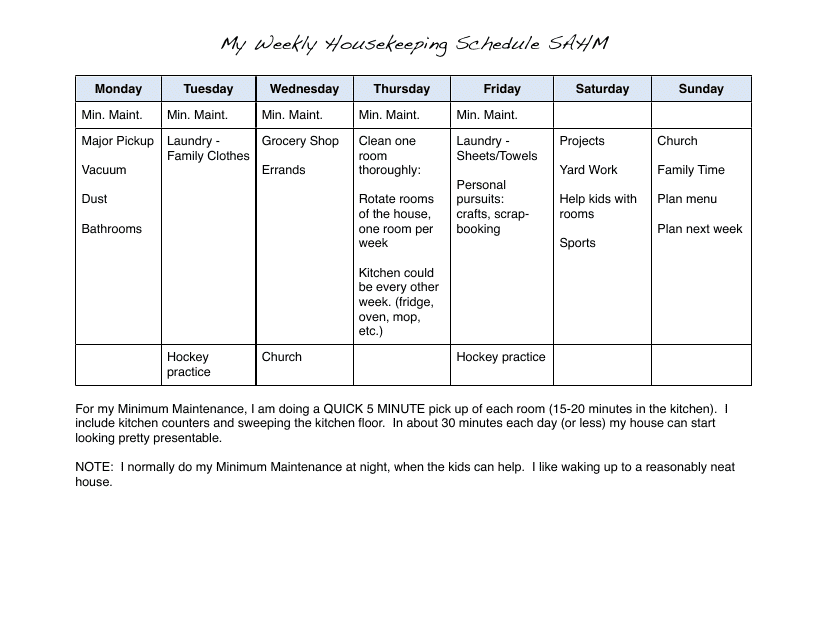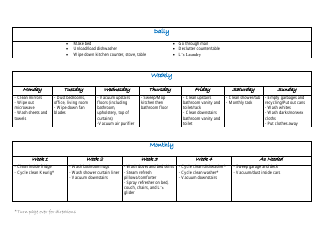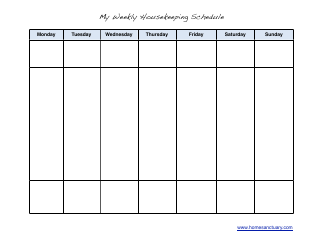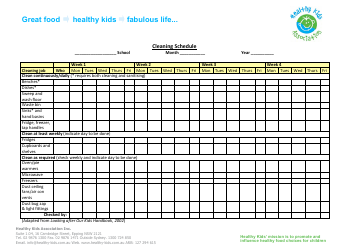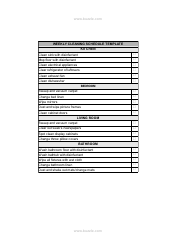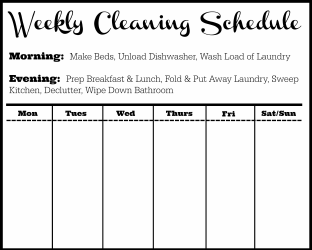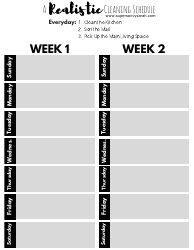Sample Weekly Housekeeping Schedule - SAHM (Stay at Home Mom)
A Sample Weekly Housekeeping Schedule for SAHM (Stay at Home Mom) is a suggested plan for dividing household chores and cleaning tasks throughout the week. It provides a structured routine for taking care of various aspects of housekeeping, such as laundry, vacuuming, dusting, meal preparation, and organizing. This schedule can help stay-at-home moms efficiently manage their time and ensure that household tasks are completed regularly and effectively.
A sample weekly housekeeping schedule for a stay-at-home mom (SAHM) can be filed by the SAHM herself. SAHMs often take charge of managing household tasks and creating schedules to ensure that daily cleaning and maintenance activities are organized and efficient. By creating a sample weekly housekeeping schedule, SAHMs can better manage their household chores and allocate time for various tasks throughout the week.
FAQ
Q: What is a SAHM?
A: SAHM stands for Stay at Home Mom. It refers to mothers who choose to stay at home to take care of their children and manage household responsibilities instead of pursuing full-time employment outside the home.
Q: Why would someone create a housekeeping schedule?
A: Creating a housekeeping schedule helps in maintaining a clean and organized home. It provides structure and guidance to ensure that necessary cleaning tasks are completed regularly and efficiently.
Q: What is a weekly housekeeping schedule?
A: A weekly housekeeping schedule is a plan that outlines the cleaning tasks to be performed on specific days of the week. It helps in dividing the workload evenly, ensuring that all areas of the home are kept clean and well-maintained throughout the week.
Q: What are the benefits of following a housekeeping schedule?
A: Following a housekeeping schedule offers several benefits, including: 1) Ensures a clean and organized home, 2) Reduces stress by breaking down cleaning tasks into manageable portions, 3) Efficiently distributes cleaning responsibilities among family members, 4) Helps establish a routine and maintain consistency in cleaning habits.
Q: What are some common tasks included in a weekly housekeeping schedule?
A: Common tasks included in a weekly housekeeping schedule typically encompass cleaning activities such as: 1) Vacuuming and mopping floors, 2) Dusting surfaces and furniture, 3) Cleaning bathrooms and kitchen, 4) Doing laundry and changing beddings, 5) Decluttering and organizing spaces.
Q: How can I create a weekly housekeeping schedule?
A: To create a weekly housekeeping schedule, you can follow these steps: 1) Assess your cleaning needs and available time, 2) Divide tasks into daily or weekly categories, 3) Assign specific tasks to each day of the week, 4) Prioritize tasks based on importance and frequency, 5) Create a visual or written schedule, 6) Adjust and refine the schedule as needed.
Q: How long should I spend on housekeeping each day?
A: The time spent on housekeeping tasks each day can vary depending on individual preferences and the size of your home. On average, allocating 30 minutes to an hour for daily cleaning tasks should be sufficient to maintain a clean and tidy home.
Q: Can I involve my family members in the housekeeping schedule?
A: Yes, involving family members in the housekeeping schedule is a great way to distribute responsibilities and teach valuable life skills. Assigning age-appropriate tasks to children can help them develop a sense of responsibility and contribute to a shared household.
Q: Is it necessary to strictly stick to the housekeeping schedule?
A: While it is beneficial to follow a housekeeping schedule, it is important to be flexible and adaptable. Life can be unpredictable, and certain circumstances may require adjustments to the schedule. The key is to maintain a balance between routine and flexibility.
Q: What if I am unable to complete all the tasks on the schedule?
A: If you are unable to complete all the tasks on the schedule due to time constraints or other reasons, do not stress. Prioritize essential tasks and focus on completing those. You can always allocate unfinished tasks to the next available time slot or adjust the schedule accordingly.
